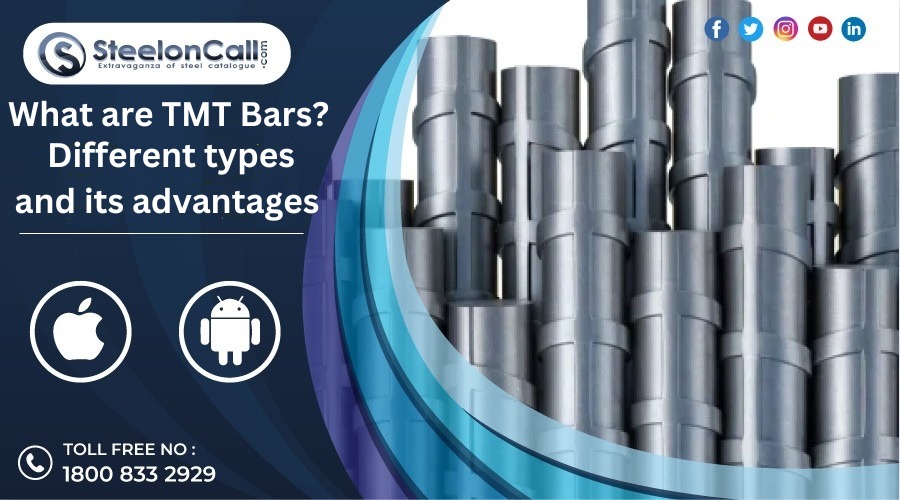TMT Bars At Best Prices. Types And Its Advantages?

TMT bars (Thermo-Mechanically Treated bars) play an essential part in the construction industry. Used primarily to reinforce concrete structures due to their exceptional strength and durability, TMTs have become widely utilized reinforcement solutions in modern projects. Here, we will examine different types of TMT bars as well as their benefits in construction projects.
1. TMT Bars in General:
Traditional TMT bars are produced using steel billets, which undergo the quenching and self-tempering process. This involves rapidly cooling the heated bars before allowing them to self-temper and improve strength and ductility over time.
2. High-Strength TMT Bars:
These special TMT bars are engineered for increased tensile strength, making them suitable for high-stress applications. To achieve enhanced mechanical properties additional alloying and heat treatment processes may be used to achieve enhanced properties in these bars.
3. Corrosion-Resistant TMT Bars:
Corrosion-resistant TMT bars have been specially treated to resist environmental factors that cause corrosion. These are ideal for structures situated near beaches or regions with high humidity as they help ensure the long-term durability of construction projects.
4. Earthquake-Resistant TMT Bars:
TMT bars can be engineered to be earthquake resistant through careful modification of their composition and heat treatment processes in order to absorb and dissipate seismic energy during earthquakes while protecting structures. These specially engineered bars help absorb and diffuse this seismic energy away from structures.
TMT Bars Advantages :
TMT bars have become an indispensable element in modern construction projects due to their exceptional combination of strength, ductility and other desirable properties that make them so indispensable. TMT bars' use has revolutionized how structures are built. TMT's popularity can be traced back to its ability to meet strength-ductility-and other advantageous properties needs--making TMT bars an essential choice in modern projects.
1. Unrivalled Strength:
A key advantage of TMT bars in construction is their outstanding strength. During their thermo-mechanical treatment process, steel bars are exposed to intense heat before controlled cooling in order to produce robust crystal structures that have higher tensile strengths than regular mild steel bars - providing structures built with TMT bars with increased resilience against heavy loads and adverse environmental conditions to make them suitable for use across a wide range of construction applications.
2. Ductility and Flexibility:
TMT bars exhibit remarkable ductility or their ability to undergo significant deformation before breaking. This quality makes TMT bars invaluable in construction environments with frequent earthquake activity; their bendable properties allow them to absorb stress applied by seismic waves without breaking. Their ductile nature also plays a crucial role in protecting structures and their occupants against catastrophic failure, helping prevent it and providing peace of mind to everyone involved in any construction projects involving TMT material.
3. Weldability and Formability:
TMT bars' weldability is another distinct advantage. Construction work often requires fabricating complex structures, and their easy weldability facilitates this task. Not only does this characteristic speed up construction processes, but it also adds significant strength to a building as welded joints strengthen different parts of it.
4. Corrosion Resistance:
Corrosion can pose an ongoing threat to structures in coastal environments or regions with high humidity. TMT bars come equipped with corrosion-resistant variants for added protection against rust and degradation over time, thus reducing maintenance needs and contributing to economic viability in harsh environmental conditions.
5. Time and Cost Efficiency:
TMT bars contribute significantly to both time and cost efficiency during construction. Their superior strength enables fewer bars without compromising structural integrity to reduce overall weight. At the same time, their ease of handling and welding hastens construction time and lowers labour costs, making TMT an economical solution for builders and developers.
6. Environmental Sustainability:
Its TMT bars make an environmentally friendly addition to construction practices. Their long lifespan means less frequent maintenance and replacement needs, reducing demand for raw materials, energy and resources over the life cycle of buildings utilizing TMT bars - making TMT an environmentally sustainable solution when selecting materials for building.
TMT bars in construction stand out for their outstanding combination of strength, ductility, weldability, corrosion resistance and overall efficiency. As the construction industry advances, TMT bars remain at the forefront, shaping how buildings are designed and constructed while providing safety, durability and sustainability in built environments. Both builders and engineers recognize TMT bars' vital role in achieving structural excellence across numerous projects.
Tmt Bars Applications:
TMT bars find widespread application across various construction projects, such as:
1. Residential Buildings:
TMT bars are widely utilized in the construction of residential buildings due to their strength, durability and cost-efficiency.
2. Commercial Complexes and High-Rise Buildings:
Large commercial complexes and high-rise buildings benefit from TMT bar's high tensile strength, as it helps ensure the structural stability of the structure.
3. Bridges and Flyovers:
TMT bars are crucial components in the construction of bridges and flyovers, providing essential reinforcement to these critical infrastructure projects.
4. Industrial Structures:
TMT bars' corrosion resistance makes them suitable for use in environments with harsh environmental conditions, making them suitable for industrial buildings where long-term exposure may be commonplace.
5. Infrastructure Projects:
TMT bars play an essential role in many infrastructure projects, such as dams, highways, and tunnels, where the durability and strength of structures are of the utmost importance.
Conclusion:
TMT bars have revolutionized the construction industry by providing an ideal combination of strength, ductility, and durability. Their various types cater to specific construction needs while offering solutions for various applications. As technology progresses further, more innovative production methods should become available that could contribute to safer structures with increased resilience - helping architects, engineers and builders meet the ever-increasing demands of construction work with confidence.

